#howwemontessori
Text
Infant Grasping Materials

When we think of Montessori we often think of Montessori schools, the Pink Tower or the Moveable Alphabet. Did you know there is a whole range of Montessori materials designed specifically for infants? Today I’m sharing some of the very first toys we can present to a Montessori child - infant grasping materials.
These materials are introduced as soon as the child can reach out their hand to pick up and grasp. This is anywhere from three to six months. The purpose is to provide the opportunity for the child to learn and practice coordinated movement of the hand. These materials are best stored in a basket on the child’ low work shelves. Alternatively, you can store them in a basket and keep near the child’s movement mat or work area (play mat).
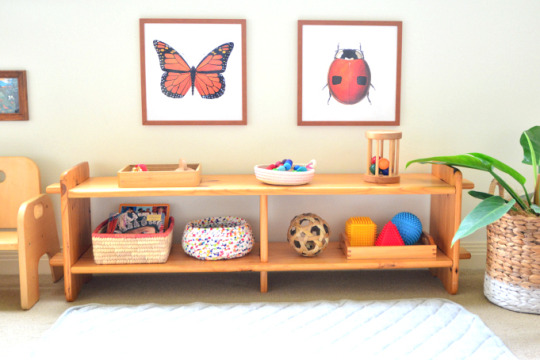
Some of the early Montessori infant grasping materials include;
Bells with Ribbon
Two bells that only ring when they clash together. The red ribbon is bright and vibrant against the gold colour of the bells. This material is extremely attractive. The child will grasp the ribbon and cause the bells to ring together. Children will be delighted at the sound they make and repeat the movements. The child is not only learning coordinated movement of their hands they are also experiencing cause and effect. The bells are 4.5cm in diameter and the red ribbon in approximately 13cm long.
Small Bell Rattle
This is the very first rattle I introduced to my son at around three months of age. It is the perfect size for a ‘first’ rattle. It is designed specifically for the very young infant’s hands. The rattle is only 1.7cm in diameter and 6cm long (in addition to the bells), it is light and easy for the child to grasp. The bells on each end are shiny and bright and will capture the child’s attention. The child learns very early to move their hands to shake the rattle and ring the bells. This is an essential item in a Montessori infant basket and it also makes a lovely gift!
Interlocking Discs
The interlocking discs are quintessential Montessori. These are best presented when you notice the child is grasping and bringing their two hands together, often close to six months of age. The interlocking discs are a set of two wooden discs (approximately 6cm in diameter) that are connected. The discs are fixed together and are sturdy, they cannot be separated. The discs are designed so that they will roll but only slowly and only for a short distance. This is ideal for a child who is learning to reach and grasp and slowly move (creep) towards a desirable object. They are also designed so when the child passes them from hand to hand there is a slight wrist rotation. This is fantastic for their development.
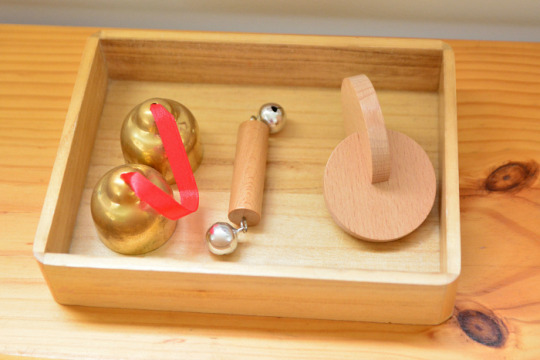
All of these materials are designed with the infant in mind. They are child safe, natural, authentic and developmentally appropriate. You can find these materials and more at Montessori Shop.
- Words and images by Kylie D’Alton @howwemontessori
#montessori#montessoriinfant#grasping#baby#montessoriathome#montessorimaterials#montessorimom#baby toys#montessoripreschool#montessorilife#montessorian#woodentoys#teachandlearn#montessoribaby#toys
0 notes
Text
The Montessori Trinomial Cube

One thing that attracts many parents to a Montessori education is the hands-on learning that occurs. In Montessori, children learn through movement, they learn by working with their hands and using their senses.
Montessori math materials are the epitome of a Montessori education. They have a built-in control of error, which means that materials guide the child, the adult or teacher does not need to correct the child; the materials give the child feedback and will tell the child when the work is complete! In the case of the Trinomial Cube, the control of error is that completed work will form a cube. The child needs to keep on working until a cube is formed.

Montessori materials start with the very concrete in the 3-6 years classroom and move to the more abstract in the older classrooms. The Trinomial Cube is a three-dimensional puzzle, which is made of 27 wooden blocks. The Trinomial Cube is the physical representation of the trinomial formula (a+b+c)3 and indirectly prepares the child to later learn Algebra.

The Trinomial Cube is presented to a child at or around 4-6 years, after the child has completed the work of the Binomial Cube. It is important to demonstrate this work to the child. We systematically deconstruct then reconstruct the cube. The child uses their senses of touch and sight, using size and colour to build the cube. It is fantastic for the child’s developing visual perception, concentration, and problem-solving skills.

The Trinomial Cube is presented in a beautiful wooden hinged box with the control image on top. It is an essential part of the Montessori 3-6 classroom and a useful homeschooling tool.
As an extension idea, ask the child to complete the work wearing a blindfold, using the send of touch only.

- Text and images by Kylie D’Alton @howwemontessori
#montessori#montessoriathome#montessorichild#montessorichildren#montessorimaterials#montessoriclassroom#montessorian#montessorimum#montessorimom#montessoripreschool#trinomialcube#montessorimath#teachandlearn#montessoriactivities#montessoriactivity#preschool#algebra#childledlearning#childled
0 notes
Text
Review of the Roman Arch

The Roman Arch is a wonderful material found in most Montessori classrooms (3-6 years). Our Roman Arch consists of a frame, 32 block pieces and three pieces making up the removable arch support. The Roman Arch is entirely wooden and is so nice to work with!
The Roman Arch is a cultural material and has really important lessons in maths and science. We use the Roman Arch to teach the child about gravity, Roman engineering, the principles of the keystone and problem solving.
When introducing the Roman Arch to the child it is important to name the material and to demonstrate piece by piece how to build the arch. Make sure to study the structure before presenting it to the child. Once you have admired the finished arch, disassemble the arch, again, piece by piece.
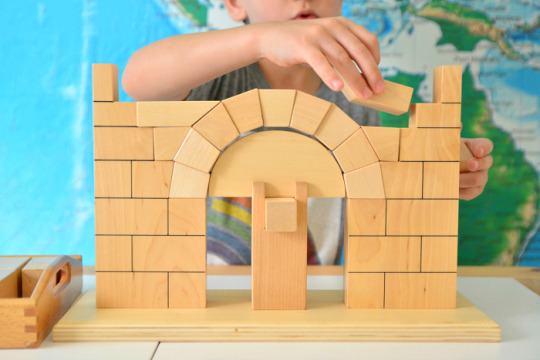
If the child needs help building the arch I suggest helping with block selection and allow the child to place the block on the arch (don’t do it for the child). As the child becomes more confident they will be able to complete the arch independently.
I love the control of error built into this material. If the child doesn’t build the arch in the correct sequence it may not stand. Remember you need to build the arch with the support structure in place. Once the arch is completed you can remove the support and see what happens!
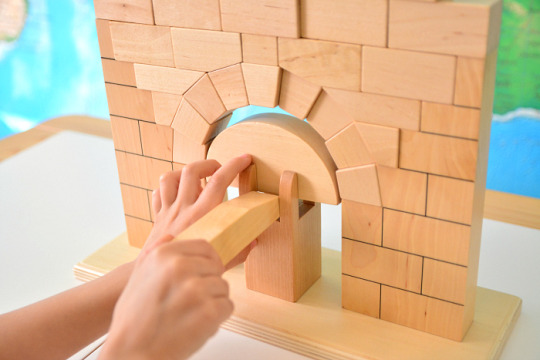
Once the child is building the arch with confidence invite them to leave out one or more blocks to see the effect on the stability of the structure. You can also introduce the names of the block pieces including the keystone (the block in the centre of the arch that locks the arch in place). See what happens when you remove the keystone!
We love to use the Roman Arch at home and I have presented it along with beautiful images of arches in Rome and around the world. This really helps the child to place the arch in the real world. You can even point out arches in books or in real life architecture to help consolidate the child’s knowledge!
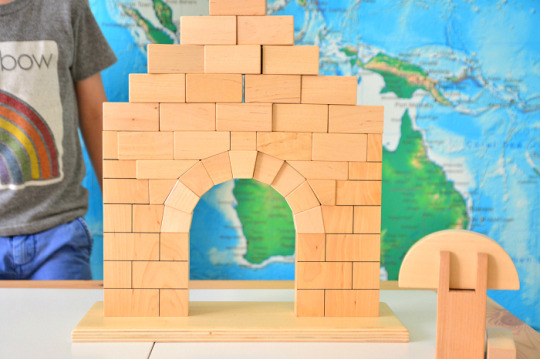
- Review written by Kylie D’Alton @howwemontessori using the Roman Arch from Montessori Shop.
#montessori#montessorimom#montessorimum#montessori preschool#montessorimaterials#montessorichild#montessorichildren#montessorian#montessoriathome#homeschool#homeschooling#education#learnandshare#preschool#kids#intermediate#work#bambini#play#montessorilife#montessoriactivity#montessoriteacher
0 notes
Text
Keeping your toddler busy in the kitchen!

Once a month Kylie D’Alton from howwemontessori writes an article for our Newsletter (subscribe here!) and this month she has done a great feature on Water Activites for Sink Play!
My son Arlo (3 in a couple of weeks) has always been a great helper in the kitchen, but often I can’t keep up with actually making dinner and finding safe ways for him to contribute! So having a few of these simple and fun water activites up my sleeve is going to be a great asset!
My daughter Florence (20 months) is also starting to show an interest in helping in the kitchen so setting her up with some muddy vegetables, a vegetable brush and a basin on the floor is the perfect way for her to contribute!
Arlo has just moved up in to the 3-6 classroom at his Montessori preschool, and he has already started to show more of an interest in phonetics and copying the shapes of letters. So anything that can help with his pencil grip is also a great activity for him just now- the transferring water with a pipette sounds like the perfect solution for keeping him from eating all my vegies before I can cook them tonight! :)
If you haven’t already signed up to our newsletter and would like to read the latest article, please email me [email protected] and I will email it straight through!
xx
#montessori#montessorichild#montessoriathome#montessorimaterials#learningthroughplay#montessoriactivity#preschool#learningisfun#toddler#toddlerinthekitchen#cookingwithkids#waterplay
0 notes